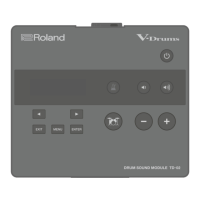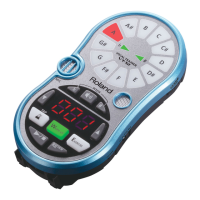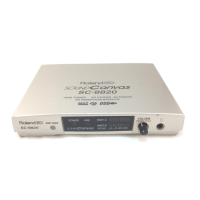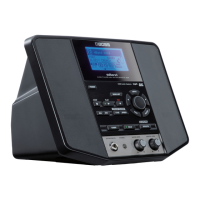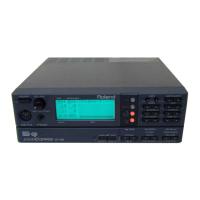Do you have a question about the Roland V-Drums TD-20X and is the answer not in the manual?
Essential guidelines for safe operation, covering electrical safety and environmental considerations.
Guidelines for connecting and using the power adapter and cord.
Recommendations for positioning the unit to avoid interference and damage.
Instructions for cleaning and care of the unit.
Overview of the TD-20X percussion sound module.
Details on the 100 drum kits and 920 sounds available.
Explanation of advanced modeling and sensing technologies for realistic play.
Description of controls and indicators on the TD-20X's top panel.
Explanation of connectors and ports on the rear of the unit.
Details on the headphone and card slots on the front panel.
Instructions for attaching the sound module to a drum stand.
Guide for connecting various drum pads, hi-hat, and kick trigger.
Steps for connecting audio output devices and headphones.
Procedure for safely powering the unit on and off.
Using the volume control knobs for master, phones, and mix-in.
Fundamental controls and navigation within the TD-20X interface.
How to adjust settings using buttons and the VALUE dial.
Explanation of automatic storage of edited values in memory.
Selecting and navigating through available drum kits.
Adjusting kit volume, tempo, and brush settings.
Procedures for copying drum kits between memory and card.
Methods for selecting pads for editing sounds.
How to select and assign instruments to pads.
Detailed editing of acoustic and electronic drum sounds.
Adjusting individual pad volume and stereo position.
Using faders to temporarily adjust mixer settings.
Enabling/disabling pad, ambience, multi-effects, and master effects.
Configuring compressor and equalizer settings for pads.
Fine-tuning sound frequencies with a three-band equalizer.
Understanding patterns and sequencer functions.
Methods for selecting and playing patterns.
Adjusting volume, pan, and mute status for pattern parts.
Step-by-step guide to recording performances into patterns.
Functions for copying, appending, erasing, and deleting patterns.
Overview of CompactFlash card functions.
Procedure for backing up unit data to a CF card.
Steps to load patterns and settings from a CF card.
Specifying the connected pad type for optimal trigger settings.
Adjusting pad sensitivity, threshold, and velocity response.
Configuring VH-12/VH-11/FD-8 hi-hat parameters.
Configuring audio output destinations for pads and effects.
Assigning functions to footswitches and pads.
Adjusting preview velocity, master EQ, and display contrast.
Setting MIDI channels for receiving and transmitting messages.
Global MIDI channel and soft-through configurations.
Connecting and using external MIDI controllers.
Auditioning kits from CF card without loading into memory.
Monitoring output levels of various jacks.
Displaying realtime pad strike and position data.
List of system error messages and recommended actions.
A comprehensive list of all factory-preset drum kits and their descriptions.
Essential guidelines for safe operation, covering electrical safety and environmental considerations.
Guidelines for connecting and using the power adapter and cord.
Recommendations for positioning the unit to avoid interference and damage.
Instructions for cleaning and care of the unit.
Overview of the TD-20X percussion sound module.
Details on the 100 drum kits and 920 sounds available.
Explanation of advanced modeling and sensing technologies for realistic play.
Description of controls and indicators on the TD-20X's top panel.
Explanation of connectors and ports on the rear of the unit.
Details on the headphone and card slots on the front panel.
Instructions for attaching the sound module to a drum stand.
Guide for connecting various drum pads, hi-hat, and kick trigger.
Steps for connecting audio output devices and headphones.
Procedure for safely powering the unit on and off.
Using the volume control knobs for master, phones, and mix-in.
Fundamental controls and navigation within the TD-20X interface.
How to adjust settings using buttons and the VALUE dial.
Explanation of automatic storage of edited values in memory.
Selecting and navigating through available drum kits.
Adjusting kit volume, tempo, and brush settings.
Procedures for copying drum kits between memory and card.
Methods for selecting pads for editing sounds.
How to select and assign instruments to pads.
Detailed editing of acoustic and electronic drum sounds.
Adjusting individual pad volume and stereo position.
Using faders to temporarily adjust mixer settings.
Enabling/disabling pad, ambience, multi-effects, and master effects.
Configuring compressor and equalizer settings for pads.
Fine-tuning sound frequencies with a three-band equalizer.
Understanding patterns and sequencer functions.
Methods for selecting and playing patterns.
Adjusting volume, pan, and mute status for pattern parts.
Step-by-step guide to recording performances into patterns.
Functions for copying, appending, erasing, and deleting patterns.
Overview of CompactFlash card functions.
Procedure for backing up unit data to a CF card.
Steps to load patterns and settings from a CF card.
Specifying the connected pad type for optimal trigger settings.
Adjusting pad sensitivity, threshold, and velocity response.
Configuring VH-12/VH-11/FD-8 hi-hat parameters.
Configuring audio output destinations for pads and effects.
Assigning functions to footswitches and pads.
Adjusting preview velocity, master EQ, and display contrast.
Setting MIDI channels for receiving and transmitting messages.
Global MIDI channel and soft-through configurations.
Connecting and using external MIDI controllers.
Auditioning kits from CF card without loading into memory.
Monitoring output levels of various jacks.
Displaying realtime pad strike and position data.
List of system error messages and recommended actions.
A comprehensive list of all factory-preset drum kits and their descriptions.
| MIDI | Yes |
|---|---|
| USB | Yes |
| Metronome | Yes |
| Display | LCD |
| Polyphony | 64 voices |
| Sequencer | Yes |
| Headphone Output | Yes |
| Power Supply | AC Adapter |
| Effects | Reverb, Delay |
| Type | Electronic drum module |
| Kits | 100 (50 preset, 50 user) |
| Connectors | MIDI In/Out, Audio Outputs |
| Trigger Inputs | 12 inputs |
